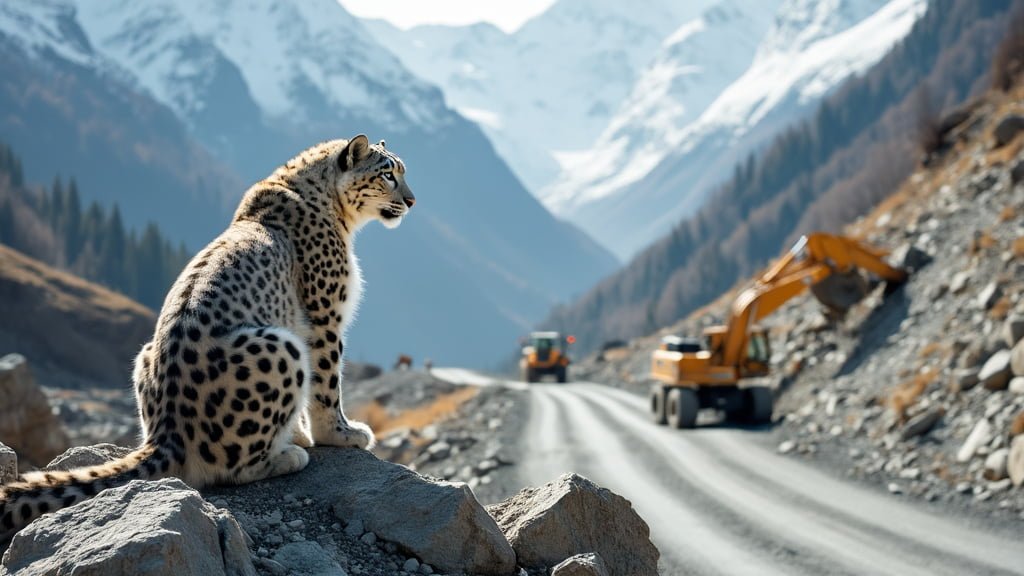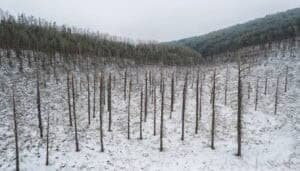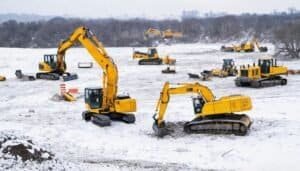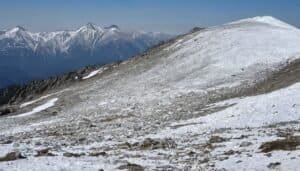Introduction
In recent years, infrastructure development in high-altitude regions has posed significant threats to the snow leopard, an already endangered species
This article explores the various ways in which infrastructure projects, such as road construction, hydroelectric power plants, deforestation, and mining, disrupt snow leopard territories
We will examine the impacts on their habitats, migration patterns, and prey availability, as well as the role of conservation efforts in mitigating these effects. Understanding these dynamics is crucial for ensuring the survival of snow leopards amidst growing human encroachment
How Road Constructions Impact Snow Leopard Habitats
Road construction in mountainous regions, particularly within the snow leopard’s habitat, poses a significant threat to this elusive species. Roads not only physically fragment their territories but also introduce a host of environmental changes that disrupt their way of life
Snow leopards are highly adapted to the steep, rugged terrains of Central and South Asia, relying on vast, undisturbed expanses of land to hunt, migrate, and breed
However, the introduction of roads through these pristine landscapes introduces barriers that can have devastating consequences for their populations
Disruption of Migration Patterns
Snow leopards depend on large territories, often covering hundreds of square miles, to find food and mates. Roads, which often cut through these territories, create physical barriers that disrupt their natural migration routes
This fragmentation limits the movement of snow leopards, making it difficult for them to access different parts of their range. A study by Jackson et al. (2020) found that roads can reduce the available habitat for snow leopards by up to 30%, forcing these animals to cross roads more frequently, which increases the risk of vehicle collisions and other dangers
Moreover, the fragmentation caused by roads can isolate snow leopard populations, leading to reduced genetic diversity
Smaller, isolated populations are more vulnerable to extinction due to inbreeding and reduced adaptability to environmental changes. This isolation also hinders young snow leopards from dispersing to new areas, a critical factor for maintaining healthy population dynamics
Increase in Human-Wildlife Conflicts
The construction of roads brings humans closer to snow leopard habitats, increasing the likelihood of human-wildlife conflicts. As roads facilitate easier access to remote areas, they open up snow leopard territories to livestock grazing, poaching, and illegal hunting
The increase in human presence can lead to more frequent encounters between snow leopards and local communities, often resulting in retaliatory killings when livestock is attacked
Research by Dutta et al. (2021) highlights that the proximity of roads to snow leopard habitats correlates with a rise in poaching incidents. Roads not only make it easier for poachers to reach these remote areas but also provide them with quick escape routes, complicating anti-poaching efforts
Additionally, the construction process itself can displace prey species, forcing snow leopards to venture closer to human settlements in search of food, further exacerbating conflict.
Impact on Prey Availability
The prey base of snow leopards, which includes species like blue sheep, ibex, and Himalayan tahr, is also significantly affected by road construction. Roads often lead to habitat degradation, reducing the availability of food for these prey species
The construction process, involving deforestation, blasting, and soil displacement, can destroy the vegetation that these herbivores depend on, leading to a decline in their populations
As prey numbers dwindle, snow leopards are forced to expand their hunting grounds, sometimes bringing them into conflict with human activities. A study by Maheshwari et al. (2022) found that in areas where road construction had significantly reduced prey populations, snow leopards were more likely to prey on livestock, leading to increased tensions with local communities
This decline in natural prey not only impacts the snow leopards’ diet but also their reproductive success, as females require adequate food resources to raise their cubs successfully
Effects of Hydroelectric Projects on Snow Leopard Territories
Hydroelectric projects, while essential for meeting energy demands, pose significant risks to snow leopard habitats. These projects typically require large-scale construction activities that can permanently alter the landscapes where snow leopards live
The creation of dams and reservoirs, as well as the infrastructure to support these facilities, often leads to habitat loss, displacement of wildlife, and changes in the local ecosystem
This section delves into how hydroelectric projects specifically impact snow leopard territories, exacerbating the threats to their survival
Habitat Submergence and Loss
One of the most direct impacts of hydroelectric projects on snow leopard habitats is the submergence of land due to the creation of reservoirs
Snow leopards typically inhabit rugged, high-altitude terrains, which are often targeted for hydroelectric development due to their fast-flowing rivers. When these rivers are dammed, vast areas of snow leopard territory can be flooded, resulting in the loss of critical habitats
According to a study by Sharma et al. (2019), the construction of large dams in the Himalayas has led to the submergence of up to 15% of the suitable habitat for snow leopards in certain regions. This loss is particularly detrimental because it often affects the most productive and biologically diverse areas within their range
The loss of such habitats not only reduces the area available for snow leopards to hunt and breed but also disrupts the ecological balance of the region, affecting both the predators and their prey
Displacement of Local Communities and Wildlife
The construction of hydroelectric projects often necessitates the displacement of both human communities and wildlife
For snow leopards, the forced relocation of prey species, such as blue sheep and Himalayan tahr, due to habitat destruction or human encroachment, can severely impact their ability to find food. Additionally, as local human populations are displaced, they may move into areas that overlap with snow leopard territories, leading to increased human-wildlife conflicts
Research by McCarthy et al. (2020) suggests that the displacement of local communities often leads to a rise in retaliatory killings of snow leopards, as these communities seek to protect their livestock from predation
Furthermore, the disruption caused by the construction process—such as noise, pollution, and the presence of workers—can drive snow leopards away from their traditional territories, forcing them to inhabit less suitable areas where they are more vulnerable to threats
Alteration of Riverine Ecosystems
Hydroelectric projects also alter the natural flow of rivers, which can have cascading effects on the entire ecosystem
Snow leopards rely on a complex web of ecological interactions to survive, and the modification of riverine ecosystems can disrupt these relationships. Changes in water flow can affect the availability of prey species, either by reducing their populations or by altering their migration patterns
In addition to the ecological impact, the construction of hydroelectric projects often leads to increased human activity in the area, further disturbing the snow leopard’s habitat. This can result in habitat fragmentation, making it more difficult for snow leopards to find food, mates, and safe areas for raising their young
Maheshwari et al. (2022) found that in regions where river systems had been altered by hydroelectric dams, snow leopard populations experienced significant declines due to the compounded effects of habitat loss and prey depletion
Deforestation and Its Impact on Snow Leopards
Deforestation, often a byproduct of infrastructure development, poses a grave threat to snow leopard territories. Although snow leopards primarily inhabit rocky, mountainous regions, the surrounding forests play a crucial role in maintaining the ecological balance of these areas
These forests support prey species, help regulate the climate, and maintain the integrity of the water cycle—all of which are vital for the survival of snow leopards
This section explores how deforestation affects snow leopard habitats, with a focus on the loss of forest cover, reduced prey density, and the long-term ecological changes that follow
Loss of Forest Cover in Key Habitats
Forests in high-altitude regions are often cleared to make way for infrastructure projects such as roads, mining, and hydroelectric plants. While snow leopards themselves are not forest-dwelling, the loss of forest cover in adjacent areas can indirectly impact their survival
Forests act as buffers, protecting the more open habitats of snow leopards from the effects of climate change, such as increased temperature and decreased water availability
A study by Maheshwari et al. (2022) indicates that deforestation in the buffer zones of snow leopard habitats can lead to the degradation of these areas, reducing their suitability for both snow leopards and their prey
The loss of forest cover also results in soil erosion, which can lead to landslides and further habitat destruction in mountainous regions. Over time, this environmental degradation reduces the availability of safe, stable areas where snow leopards can hunt and raise their young
Reduced Prey Density and Hunting Grounds
Deforestation directly impacts the prey species that snow leopards rely on for food. Herbivores such as blue sheep, ibex, and Himalayan tahr depend on forested areas for shelter and food
When these forests are cleared, the populations of these animals often decline due to the loss of their natural habitat. This reduction in prey density forces snow leopards to travel greater distances to find food, increasing their energy expenditure and reducing their overall fitness
According to research by Dutta et al. (2021), in areas where deforestation has significantly reduced prey populations, snow leopards have been observed to alter their hunting strategies, often with less success
The decline in prey also correlates with an increase in human-wildlife conflicts, as snow leopards may turn to livestock as an alternative food source
This behavior not only increases the risk of retaliatory killings by local herders but also disrupts the delicate balance of the ecosystem, as snow leopards play a critical role in regulating prey populations
Long-Term Ecological Changes
The effects of deforestation are not limited to the immediate loss of trees; they also involve long-term ecological changes that can have profound consequences for snow leopards
The removal of forests can lead to shifts in local climate patterns, such as reduced rainfall and increased temperatures. These changes can make the remaining habitats less suitable for both snow leopards and their prey
Moreover, deforestation can disrupt the water cycle, leading to reduced water availability in the high-altitude regions where snow leopards live. As rivers and streams dry up or change course, the availability of water for prey species also decreases, further stressing the food chain
A study by Sharma et al. (2019) highlights that deforestation can lead to a decline in vegetation cover, which in turn reduces the habitat’s ability to support herbivores, ultimately impacting snow leopard populations. Over time, these ecological changes can lead to a decline in snow leopard numbers, as the species struggles to adapt to a rapidly changing environment
Mining Projects and Their Threat to Snow Leopard Territories
Mining projects, particularly in mountainous regions, pose a significant threat to snow leopard territories. These projects often involve the extraction of minerals, metals, and other resources from areas that overlap with snow leopard habitats
The process of mining can lead to extensive environmental degradation, habitat destruction, and pollution, all of which have severe consequences for the snow leopard population
This section explores the specific ways in which mining projects endanger snow leopards, focusing on the destruction of natural landscapes, pollution, and the effectiveness of mitigation measures
Destruction of Natural Landscapes
Mining activities typically involve the removal of large amounts of earth, rock, and vegetation, leading to the destruction of natural landscapes. In snow leopard habitats, this can result in the permanent loss of critical areas needed for hunting, breeding, and shelter
The open-pit mining method, commonly used in these regions, is particularly destructive, as it involves the complete removal of the surface layer, which includes the snow leopard’s habitat
Research by McCarthy et al. (2020) found that in areas where mining has been extensive, up to 20% of snow leopard habitat has been lost, with some regions experiencing even greater losses
This destruction not only reduces the available territory for snow leopards but also fragments the landscape, making it difficult for these animals to move between different parts of their range. This fragmentation can isolate populations, reducing genetic diversity and increasing the risk of inbreeding
Pollution and Its Effects on Wildlife
Mining operations are also a major source of pollution, which can have devastating effects on the local environment and wildlife. The use of toxic chemicals in mining processes, such as cyanide in gold extraction, can lead to the contamination of soil, water, and vegetation
This pollution can harm both the snow leopards and their prey, as contaminated water sources and reduced vegetation quality diminish the health and availability of prey species
A study by Sharma et al. (2019) found that water contamination from mining operations had led to a decline in the populations of key prey species in certain snow leopard habitats. This decline forces snow leopards to expand their hunting areas, often bringing them closer to human settlements and increasing the likelihood of conflict
Additionally, the pollution generated by mining can affect snow leopards directly, as they may ingest toxic substances through contaminated prey or water, leading to health issues that can reduce their survival and reproductive success
Mitigation Measures and Their Effectiveness
While mining companies are often required to implement mitigation measures to reduce their environmental impact, the effectiveness of these measures is frequently questionable
Environmental Impact Assessments (EIAs) are supposed to identify the potential impacts of mining projects on snow leopard habitats and propose strategies to minimize harm. However, these assessments are not always comprehensive or enforced, leading to inadequate protection for snow leopards
According to Maheshwari et al. (2022), many EIAs conducted in snow leopard territories have been criticized for underestimating the long-term impacts of mining and for failing to include adequate measures for habitat restoration
In some cases, the mitigation strategies proposed, such as reforestation or the creation of wildlife corridors, have been poorly implemented or not maintained, rendering them ineffective
Furthermore, the financial and logistical challenges of restoring habitats in remote, mountainous areas mean that even well-intentioned efforts often fall short of their goals
Conservation Efforts to Mitigate Infrastructure Impacts
As infrastructure projects continue to encroach on snow leopard territories, various conservation efforts have been implemented to mitigate their negative impacts
These efforts are critical for preserving snow leopard populations and ensuring that their habitats remain viable. Conservation strategies include the establishment of protected areas, the creation of wildlife corridors, rigorous environmental impact assessments, and community involvement in conservation activities
This section will explore these strategies and assess their effectiveness in safeguarding snow leopard territories
Protected Areas and Wildlife Corridors
One of the most effective strategies for protecting snow leopards is the establishment of protected areas where human activities are limited or prohibited
These areas provide safe havens for snow leopards, allowing them to hunt, breed, and roam without the immediate threat of habitat destruction or human interference. In addition to protected areas, wildlife corridors are created to connect fragmented habitats, enabling snow leopards to move freely between different parts of their range
According to a study by Jackson et al. (2020), the creation of protected areas has been instrumental in stabilizing snow leopard populations in several regions across Central Asia
These protected zones, when combined with wildlife corridors, help maintain genetic diversity by facilitating the movement of individuals between isolated populations
However, the effectiveness of these measures often depends on proper management and enforcement. In some cases, protected areas are poorly monitored, allowing illegal activities such as poaching or unregulated grazing to continue
Environmental Impact Assessments
Environmental Impact Assessments (EIAs) are a critical tool in ensuring that infrastructure projects do not irreparably harm snow leopard habitats
These assessments are conducted before the initiation of projects like roads, dams, and mining operations to evaluate the potential environmental impacts and to develop strategies to mitigate them
EIAs are supposed to consider the specific needs of snow leopards, including their reliance on large, undisturbed territories and the importance of prey availability
Research by McCarthy et al. (2020) has shown that when EIAs are conducted rigorously and transparently, they can significantly reduce the negative impacts of infrastructure projects on snow leopard territories
However, the effectiveness of EIAs is often compromised by inadequate enforcement, lack of transparency, and pressure from development interests. In some cases, the recommendations of EIAs are ignored or only partially implemented, leading to ongoing habitat degradation
Community Involvement and Education
Community involvement is another crucial aspect of snow leopard conservation. Local communities often share the same landscapes as snow leopards, and their activities—such as livestock grazing and resource extraction—can directly impact snow leopard habitats
Engaging these communities in conservation efforts, through education and economic incentives, can help reduce human-wildlife conflicts and promote sustainable land use practices
Programs such as the Snow Leopard Trust’s community-based conservation initiatives have proven successful in reducing retaliatory killings of snow leopards by offering livestock insurance schemes and alternative livelihoods for local herders
These programs also emphasize the importance of snow leopards to the local ecosystem, fostering a sense of stewardship among community members. According to Dutta et al. (2021), areas where communities are actively involved in conservation efforts have seen a significant reduction in poaching and habitat destruction
Challenges and Future Directions
While significant progress has been made in snow leopard conservation, challenges remain. The increasing demand for infrastructure development in remote regions continues to put pressure on snow leopard habitats. Moreover, climate change poses additional threats, as it can exacerbate habitat loss and alter prey availability
To address these challenges, future conservation efforts must focus on strengthening the enforcement of protected areas, improving the rigor and transparency of EIAs, and expanding community-based conservation programs
Additionally, international cooperation is essential, as snow leopard habitats often span multiple countries. Organizations like the Global Snow Leopard and Ecosystem Protection Program (GSLEP) work to coordinate conservation efforts across national borders, ensuring a unified approach to snow leopard conservation
Conclusion
The survival of snow leopards is intricately linked to the preservation of their natural habitats, which are increasingly under threat from infrastructure development
Road construction, hydroelectric projects, deforestation, and mining all contribute to the fragmentation and degradation of the mountainous regions that snow leopards call home
These activities disrupt migration patterns, reduce prey availability, and increase the likelihood of human-wildlife conflicts, all of which place additional stress on this already vulnerable species
Conservation efforts are crucial in mitigating these threats. The establishment of protected areas and wildlife corridors, rigorous environmental impact assessments, and the active involvement of local communities in conservation initiatives are all vital strategies in safeguarding snow leopard populations
However, these measures must be implemented effectively and supported by strong enforcement and international cooperation to address the ongoing challenges posed by infrastructure development and climate change
Ultimately, the future of snow leopards depends on a balanced approach that accommodates both the need for development and the necessity of preserving the natural environments that these magnificent animals depend on. By prioritizing conservation and sustainable development, it is possible to protect snow leopard habitats and ensure that this species continues to thrive in the wild for generations to come











